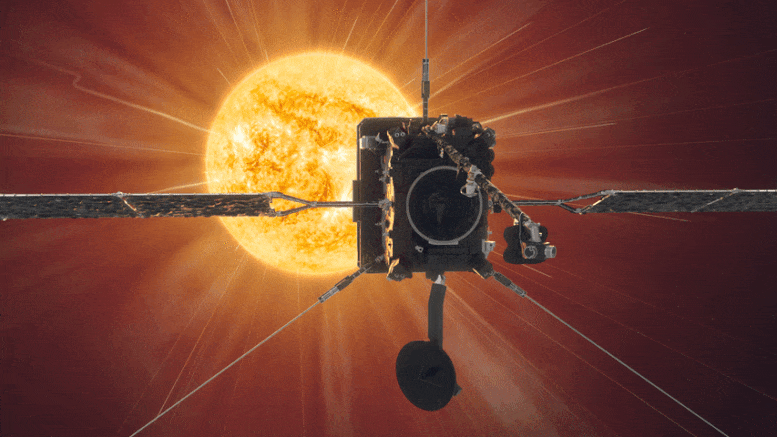Animacja Solar Orbiter Europejskiej Agencji Kosmicznej. Źródło: ESA / Medialab
Najnowsze zdjęcia Solar Orbiter pokazują pełne słońce w niespotykanej dotąd szczegółowości. Zdjęcie zostało zrobione 7 marca 2022 roku, kiedy statek kosmiczny przelatywał bezpośrednio między Ziemią a Słońcem.
Jedno ze zdjęć uchwyconych przez urządzenie Extreme Ultraviolet Imager (EUI) to najwyższej rozdzielczości zdjęcie tarczy pełnego Słońca i zewnętrznej atmosfery, korony, jakie kiedykolwiek wykonano.
Kolejne zdjęcie wykonane przez instrument Spectral Imaging of the Coronal Environment (SPICE) przedstawia pierwsze pełne zdjęcie Słońca od 50 lat i najlepsze zdjęcie wykonane wzdłuż fali Lyman beta promieniowania ultrafioletowego emitowanego przez wodór.
Zdjęcia zostały wykonane, gdy orbiter słoneczny znajdował się w odległości około 75 milionów kilometrów, w połowie drogi między naszym światem a jego gwiazdą macierzystą. Teleskop wysokiej rozdzielczości EUI rejestruje obrazy o tak wysokiej rozdzielczości przestrzennej, że z tej bliskiej odległości wymagana jest mozaika 25 pojedynczych obrazów, aby pokryć całe Słońce. Wykonane jeden po drugim, pełne zdjęcie zostało wykonane w ciągu ponad czterech godzin, ponieważ każdy fragment zajmuje około 10 minut, wliczając w to czas, w którym sonda kosmiczna przekierowuje się z jednej części na drugą.

Słońce widziane przez sondę Solar Orbiter w ekstremalnym ultrafiolecie z odległości około 75 milionów km. Obraz jest mozaiką 25 pojedynczych zdjęć wykonanych 7 marca 2022 r. przez Teleskop Wysokiej Rozdzielczości Instrumentu Obrazowania Ultrafioletowego (EUI). To zdjęcie wykonano przy długości fali 17 nanometrów, w skrajnym ultrafiolecie widma elektromagnetycznego, ukazując górną część atmosfery Słońca, koronę, która ma temperaturę około miliona stopni Celsjusza. Dołączono również obraz Ziemi przedstawiający skalę na godzinie 2. Źródło: ESA i NASA/Solar Orbiter/EUI Team; Przetwarzanie danych: E. Kraaikamp (ROB)
W sumie ostateczny obraz Zawiera ponad 83 miliony pikseli w siatce 9148 x 9112 pikseli. Dla porównania, ten obraz ma rozdzielczość dziesięciokrotnie lepszą niż ta, którą może wyświetlić ekran telewizora 4K.
EUI przedstawia Słońce na długości fali 17 nanometrów, w obszarze ekstremalnego ultrafioletu widma elektromagnetycznego. To ujawnia górną warstwę atmosfery Słońca, koronę, która ma temperaturę około miliona stopni[{” attribute=””>Celsius.

Solar Orbiter took images of the Sun on March 7, from a distance of roughly 75 million kilometres, using its Spectral Imaging of the Coronal Environment (SPICE) instrument. SPICE takes simultaneous “spectral images” at several different wavelengths of the extreme ultraviolet spectrum by scanning its spectrometer slit across a region on the Sun. The different wavelengths recorded correspond to different layers in the Sun’s lower atmosphere. Purple corresponds to hydrogen gas at a temperature of 10,000°C, blue to carbon at 32,000°C, green to oxygen at 320,000°C, yellow to neon at 630,000°C. Each full-Sun image is made up of a mosaic of 25 individual scans. It represents the best full Sun image taken at the Lyman beta wavelength of ultraviolet light that is emitted by hydrogen gas. Credit: ESA & NASA/Solar Orbiter/SPICE team; Data processing: G. Pelouze (IAS)
At the 2 o’clock (near the image of the Earth for scale) and 8 o’clock positions on the edges of the Sun, dark filaments can be seen projecting away from the surface. These ‘prominences’ are prone to erupt, throwing huge quantities of coronal gas into space and creating ‘space weather’ storms.
In addition to EUI, the SPICE instrument was also recording data during the crossing. These too needed to be pieced together as a mosaic.
SPICE is designed to trace the layers in the Sun’s atmosphere from the corona, down to a layer known as the chromosphere, getting closer to the surface. The instrument does this by looking at the different wavelengths of extreme ultraviolet light that come from different atoms.

Taking the Sun’s temperature. Credit: ESA & NASA/Solar Orbiter/SPICE team; Data processing: G. Pelouze (IAS)
In the SPICE sequence of images purple corresponds to hydrogen gas at a temperature of 10,000°C, blue to carbon at 32,000°C, green to oxygen at 320,000°C, yellow to neon at 630,000°C.
This will allow solar physicists to trace the extraordinarily powerful eruptions that take place in the corona down through the lower atmospheric layers. It will also allow them to study one of the most puzzling observations about the Sun: how the temperature is rising through the ascending atmospheric layers.
Usually the temperature drops as you move away from a hot object. But above the Sun, the corona reaches a million degrees Celsius whereas the surface is only about 5000°C. Investigating this mystery is one of the key scientific objectives of Solar Orbiter.
The images were taken on 7 March, precisely when Solar Orbiter crossed the Sun-Earth line, so the images can be compared with Earth-bound solar instruments and cross-calibrated. This will make it easier to compare results from different instruments and observatories in future.
On March 26, Solar Orbiter reaches another mission milestone: its first close perihelion. The spacecraft is now inside the orbit of Mercury, the inner planet, taking the highest resolution images of the Sun it can take. It is also recording data on the solar wind of particles that flows outwards from the Sun.
And this is just the start, over the coming years the spacecraft will repeatedly fly this close to the Sun. It will also gradually raise its orientation to view the Sun’s previously unobserved polar regions.
Solar Orbiter is a space mission of international collaboration between ESA and NASA.

„Odkrywca. Nieprzepraszający przedsiębiorca. Fanatyk alkoholu. Certyfikowany pisarz. Wannabe tv ewangelista. Fanatyk Twittera. Student. Badacz sieci. Miłośnik podróży.”



